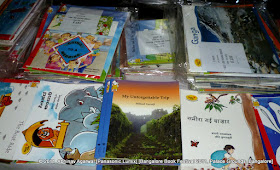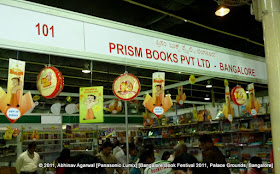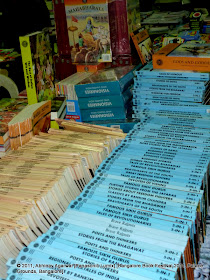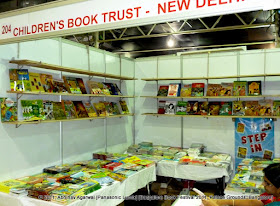I had visited the Bangalore Book Festival last year (see blog post and post with photos). This year also the festival is running at the Bangalore Palace Grounds.
From the Deccan Herald article, Bangalore book fair begins today, we can learn that this festival has more than 300 stalls, of which 94 stalls have been set up exclusively for Kannada books. The festival closes Nov 27 (Sunday), and entry fees for adults is Rs 20.
The arrangements, for purchasing tickets as well as for parking, are much better this year compared to last year. Metal rails were used for four different ticketing windows to keep the queues in order. There were several people in the parking lot to help people park their cars into different rows.
They also had a large billboard put up displaying a list of all the exhibitors at the sale, and their stall locations. If you were interested in a particular publisher's stall, you could use this to go directly to that aisle. They were also selling a small booklet with a list and advertisements from all the publishers, in case one was interested.
Sahitya Akademi had stall in the first aisle. In fact they had stall number 1.
Apart from the CBT stall one other stall I was looking very much to visit was Pratham Books (book site). I had recently ordered their books and was very impressed by the quality of the printing, the illustrations, and the writing. And the prices are absolutely stunningly low. I mean, think Rs 15 and up. Fifteen rupees, and even 30 and Rs 40 for most books is a deal. It's a steal. When so many of the Barbie and Disney books sell for a hundred, two hundred, and even more, with dubious educational values, the Pratham Books are simply amazing.
They had books in English, Hindi, and Kannada at the stall - they publish in 11 Indian languages. We picked up a set (numbered Set 18) for Rs 110, which is a collection of five books, priced between Rs 15 and Rs 35. With their already amazingly low prices it was unsurprising that the books were not being sold at a discount, unlike other stalls where a 10% discount was pretty much the norm.
The Ramakrishna Math had a stall too. You could see a large poster of Swami Vivekananda. Most books are very reasonably priced. I picked one up - a collection of short stories for children written by Sister Nivedita.
How could I not snap a pic of this stall - Abhinava publishers!
The Kannada University Hampi stall.
Amar Chitra Katha publishers (ACK Media) had a stall, with a surfeit of Amar Chitra Katha comics.
Navneet Publishers had some nice books where you could cut out pre-marked sections and construct different models. They had also put up some of those models for people to see before buying.
Interestingly enough, and I didn't know this before, but a publisher named Leftword Books had a stall. Now, the word is a dead giveaway, isn't it? Leftword Books! And in case you still don't get it, take a look at the books on display: "A World to Win: Essays on the Communist Manifesto" - penned by, among others, Irfan Habib, a stalwart among communist hagiographers (sorry, "Marxist historiographer" or "eminent historian" (book) would be better words), and edited by Prakash Karat, a leading luminary of the Communist Party of India. Or "The Agrarian Question in Marx and his Successors", or "Imperialism" by Lenin. I imagine there are still people who hold romantically flawed notions of communism, but it is a settled question that communism killed more people in the twentieth century than all famines and wars combined.
Well, for what it's worth, I think it is good that such freedom of expression lives on in India - the space and freedom to hold differing opinions and contrarian views, a tradition that has existed and thrived for literally thousands of years in this country - where intellectual differences are settled through civilized discourse and debate. It is sad therefore to see both right-wing extremists and liberals in India today not believe in honest debate (see Sagarika Ghose for instance (this, this), a staunch liberal whose stock-in-trade tricks consist of a bag of misrepresentations, outright biases, hidden agendas masquerading as honest opinions, and sometimes outright deceit - see especially this).
The CBT (Children's Book Trust), founded in 1957 by "by one of the India’s most celebrated cartoonist Keshav Shankar Pillai"# was a good place to get some pretty good bargains. They have published excellent and very reasonably priced books for chilren in India for decades now, and their contributions in this field deserve to be told to better publicized. The books are of high quality - i.e. the content, and are very reasonably priced. Two prominently placed books were on India's former Prime Ministers from the Nehru dynasty - Srimati Indira Gandhi and Pandit Jawaharlal Nehru.
The Penguin stall had a large collection of classics, among other bestsellers.
I counted at least two stalls devoted to books on Islam. The "Discover Islam Education Trust" stall had a friendly and courteous gentleman handing free copies of a book on Islam.
Higginbothams used to be a very recognizable and popular fixture on Indian Railway stations, when travel on trains was much safer and cleaner. Reading paperbacks on a day or two-day long journey has been an inextricable part of so many millions of lives that a part of me feels somewhat sad and nostalgic that this is slowly going to remembered mostly through movies and songs.
One of India's oldest publishing houses, Motilal Banarsidass (Wikipedia) was also present.
The ISKCON Bangalore book stall.
© 2011, Abhinav Agarwal. All rights reserved.
From the Deccan Herald article, Bangalore book fair begins today, we can learn that this festival has more than 300 stalls, of which 94 stalls have been set up exclusively for Kannada books. The festival closes Nov 27 (Sunday), and entry fees for adults is Rs 20.
The arrangements, for purchasing tickets as well as for parking, are much better this year compared to last year. Metal rails were used for four different ticketing windows to keep the queues in order. There were several people in the parking lot to help people park their cars into different rows.
They also had a large billboard put up displaying a list of all the exhibitors at the sale, and their stall locations. If you were interested in a particular publisher's stall, you could use this to go directly to that aisle. They were also selling a small booklet with a list and advertisements from all the publishers, in case one was interested.
Sahitya Akademi had stall in the first aisle. In fact they had stall number 1.
Apart from the CBT stall one other stall I was looking very much to visit was Pratham Books (book site). I had recently ordered their books and was very impressed by the quality of the printing, the illustrations, and the writing. And the prices are absolutely stunningly low. I mean, think Rs 15 and up. Fifteen rupees, and even 30 and Rs 40 for most books is a deal. It's a steal. When so many of the Barbie and Disney books sell for a hundred, two hundred, and even more, with dubious educational values, the Pratham Books are simply amazing.
They had books in English, Hindi, and Kannada at the stall - they publish in 11 Indian languages. We picked up a set (numbered Set 18) for Rs 110, which is a collection of five books, priced between Rs 15 and Rs 35. With their already amazingly low prices it was unsurprising that the books were not being sold at a discount, unlike other stalls where a 10% discount was pretty much the norm.
The Ramakrishna Math had a stall too. You could see a large poster of Swami Vivekananda. Most books are very reasonably priced. I picked one up - a collection of short stories for children written by Sister Nivedita.
How could I not snap a pic of this stall - Abhinava publishers!
The Kannada University Hampi stall.
Amar Chitra Katha publishers (ACK Media) had a stall, with a surfeit of Amar Chitra Katha comics.
Navneet Publishers had some nice books where you could cut out pre-marked sections and construct different models. They had also put up some of those models for people to see before buying.
Interestingly enough, and I didn't know this before, but a publisher named Leftword Books had a stall. Now, the word is a dead giveaway, isn't it? Leftword Books! And in case you still don't get it, take a look at the books on display: "A World to Win: Essays on the Communist Manifesto" - penned by, among others, Irfan Habib, a stalwart among communist hagiographers (sorry, "Marxist historiographer" or "eminent historian" (book) would be better words), and edited by Prakash Karat, a leading luminary of the Communist Party of India. Or "The Agrarian Question in Marx and his Successors", or "Imperialism" by Lenin. I imagine there are still people who hold romantically flawed notions of communism, but it is a settled question that communism killed more people in the twentieth century than all famines and wars combined.
Well, for what it's worth, I think it is good that such freedom of expression lives on in India - the space and freedom to hold differing opinions and contrarian views, a tradition that has existed and thrived for literally thousands of years in this country - where intellectual differences are settled through civilized discourse and debate. It is sad therefore to see both right-wing extremists and liberals in India today not believe in honest debate (see Sagarika Ghose for instance (this, this), a staunch liberal whose stock-in-trade tricks consist of a bag of misrepresentations, outright biases, hidden agendas masquerading as honest opinions, and sometimes outright deceit - see especially this).
The CBT (Children's Book Trust), founded in 1957 by "by one of the India’s most celebrated cartoonist Keshav Shankar Pillai"# was a good place to get some pretty good bargains. They have published excellent and very reasonably priced books for chilren in India for decades now, and their contributions in this field deserve to be told to better publicized. The books are of high quality - i.e. the content, and are very reasonably priced. Two prominently placed books were on India's former Prime Ministers from the Nehru dynasty - Srimati Indira Gandhi and Pandit Jawaharlal Nehru.
The Penguin stall had a large collection of classics, among other bestsellers.
I counted at least two stalls devoted to books on Islam. The "Discover Islam Education Trust" stall had a friendly and courteous gentleman handing free copies of a book on Islam.
Higginbothams used to be a very recognizable and popular fixture on Indian Railway stations, when travel on trains was much safer and cleaner. Reading paperbacks on a day or two-day long journey has been an inextricable part of so many millions of lives that a part of me feels somewhat sad and nostalgic that this is slowly going to remembered mostly through movies and songs.
One of India's oldest publishing houses, Motilal Banarsidass (Wikipedia) was also present.
The ISKCON Bangalore book stall.
© 2011, Abhinav Agarwal. All rights reserved.























































